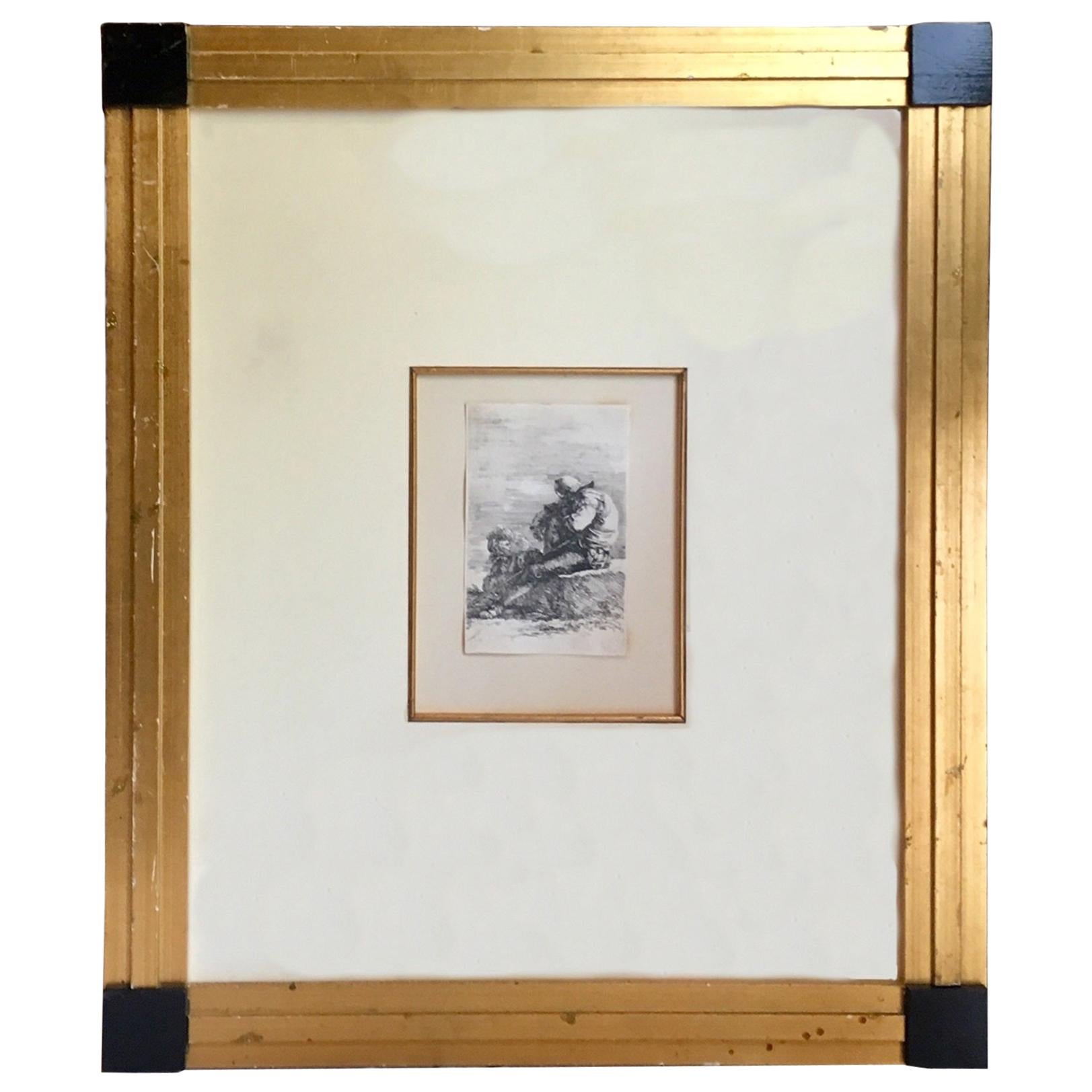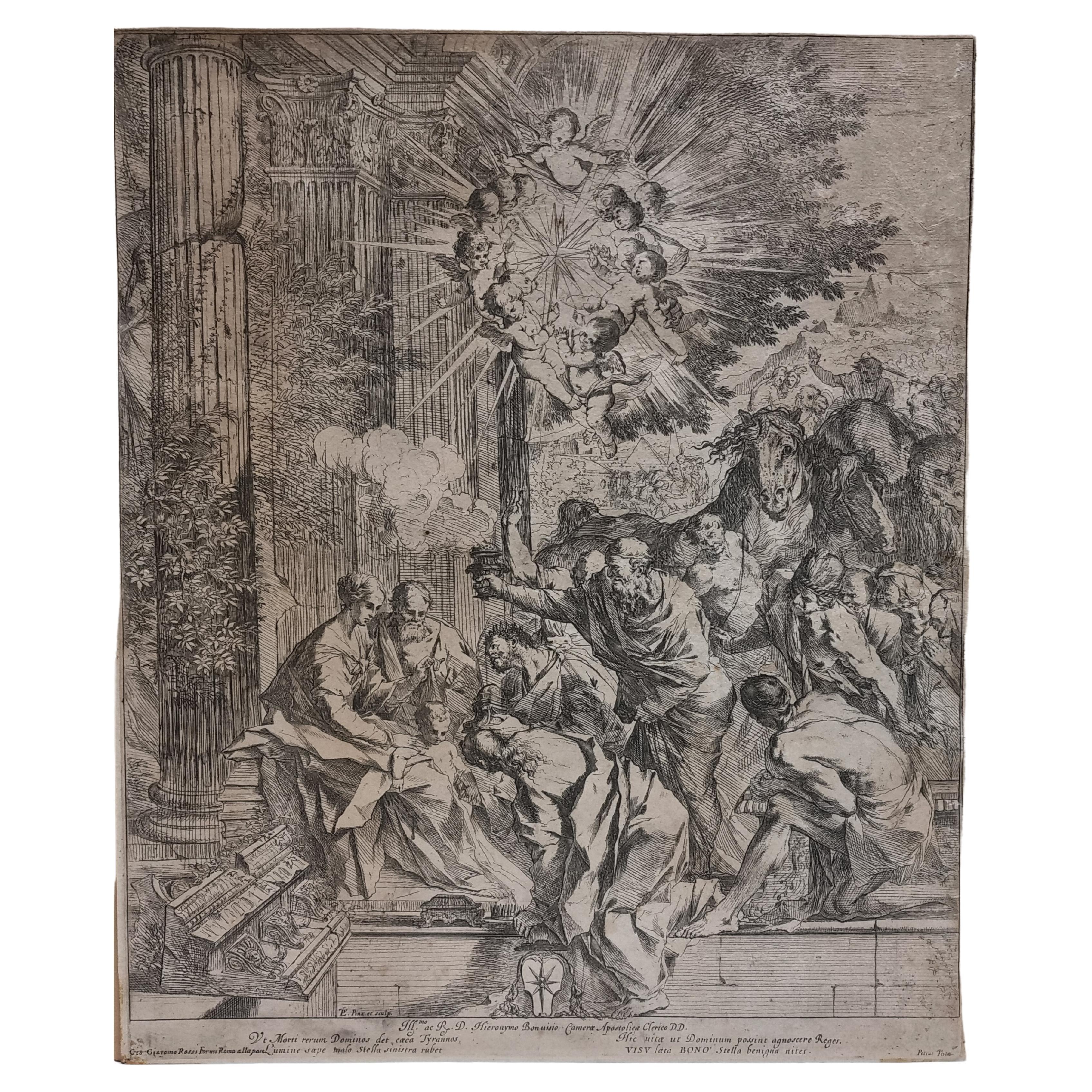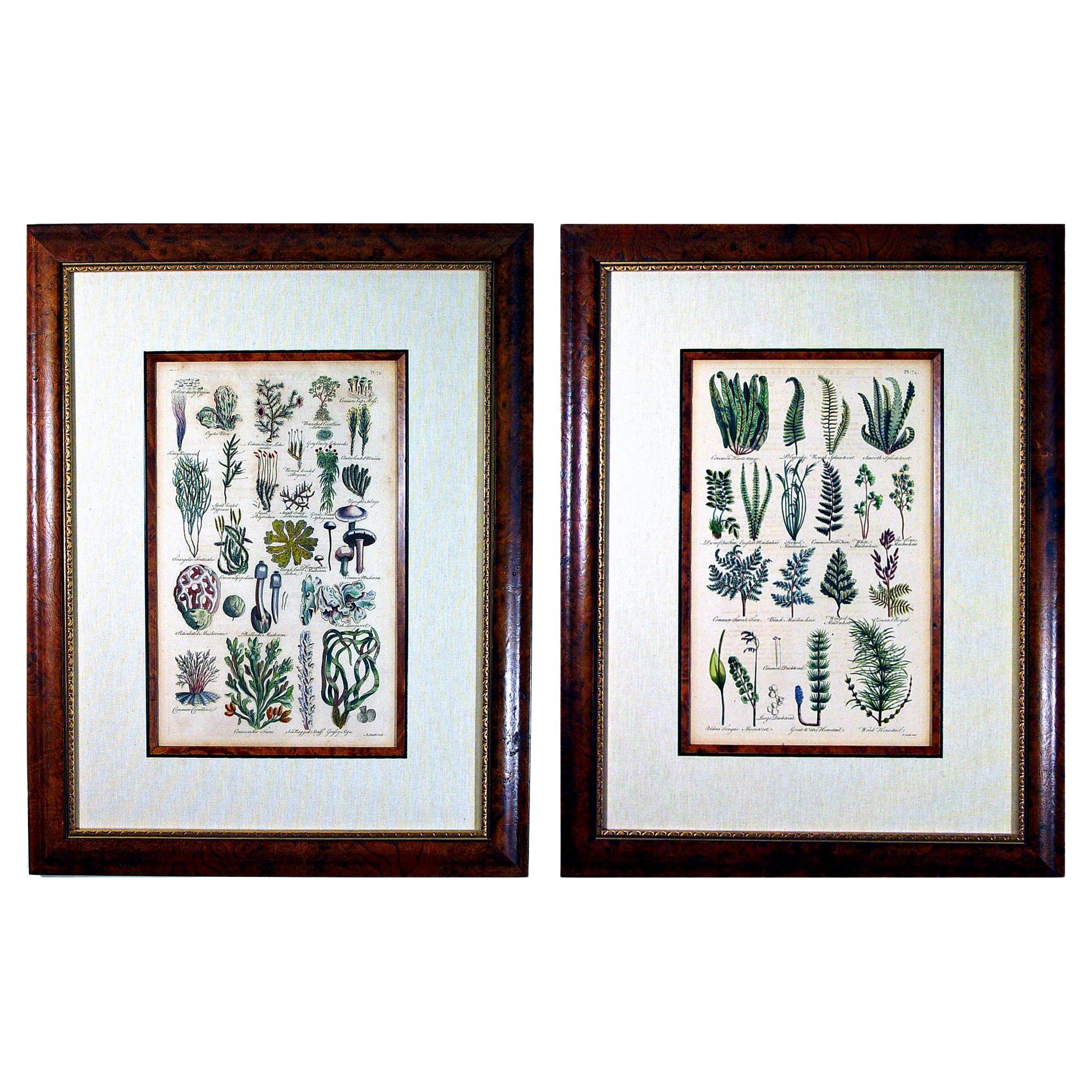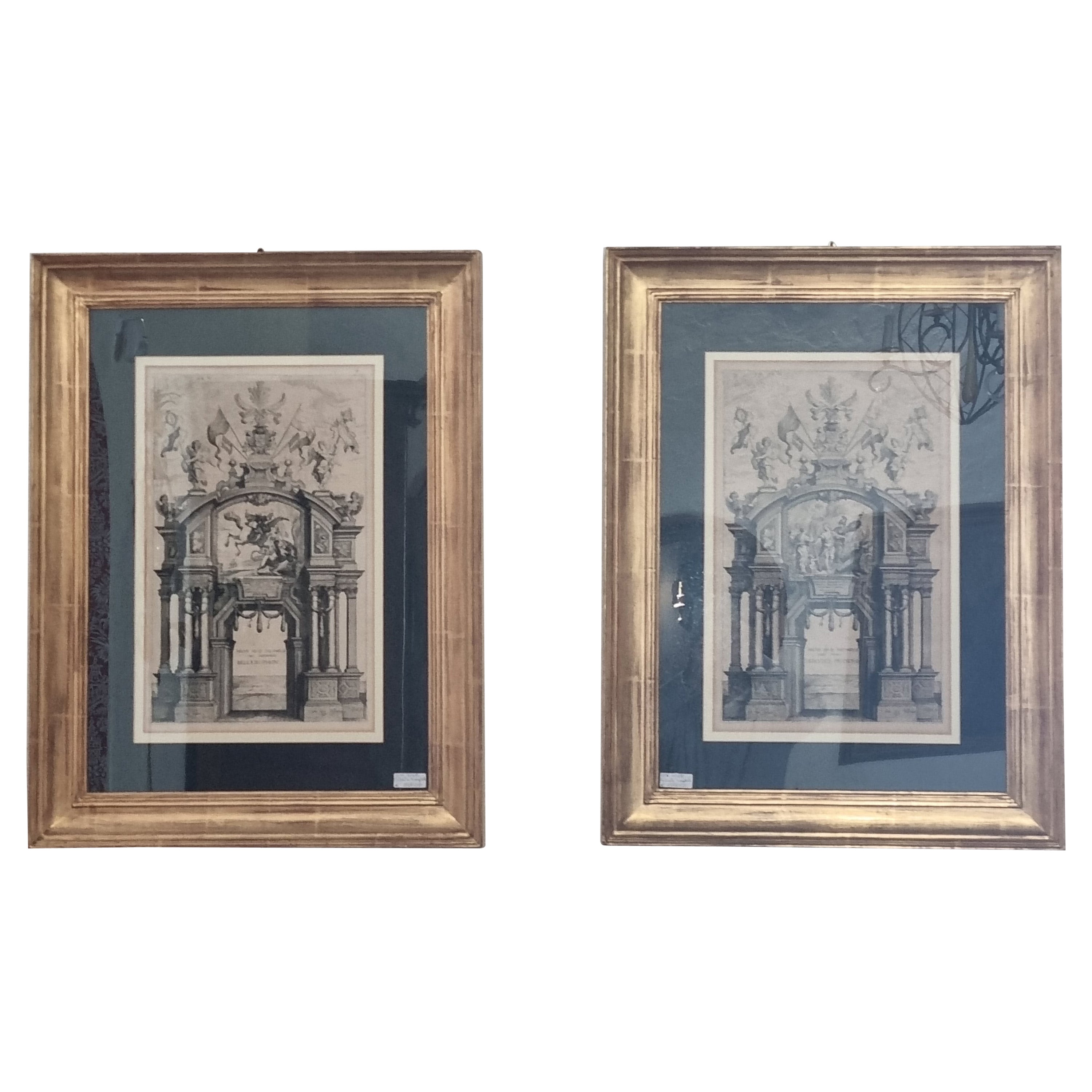Items Similar to 17th Century Etchingn and Drypoint" Ceres and Phytalus" by Salvator Rosa, 1662
Want more images or videos?
Request additional images or videos from the seller
1 of 11
17th Century Etchingn and Drypoint" Ceres and Phytalus" by Salvator Rosa, 1662
About the Item
" Ceres and Phytalus"
To left, Phytalus, kneeling, receives the fig tree from the goddess Ceres, standing to right, as a reward for his hospitality. Etching and drypoint, circa 1662, signed at lower center.
Example of the second state of two with the plate retouched in Phytalus's right foot and in the profile of Ceres, to which a third lock of hair is also added.
A fine impression, printed on contemporary laid paper with "fluer-de-lys in a circle with grapes" watermark, wide margins, very good condition.
The work describes the myth of Ceres that, hosted by Phytalus in his home, gives him the fig tree, which was hitherto unknown to men, as a sign of gratitude.
Some scholars argue that the subject is inspired by the Life of Theseus of Plutarch and others that the work is more banally due to the predilection of the artist for the fruit of the fig tree.
The work is mentioned in a letter written by Salvator Rosa to his friend Ricciardi in 1662 from his hermitage in the villa of Strozzavolpe near Poggibonsi, along with other famous works: Polycrates, Democritus, Alexander and Diogenes, Plato's Academy, Diogenes Throwing the Bowl, and the Death of Atilius Regulus. We can therefore conclude that 1662 was a particularly happy and fruitful year for the engraver Rosa, who linked his fame as a great graphic artist to the copperplates executed during this period. The subject depicted in our print illustrates the myth of Ceres who, hosted by Phytalius in his home, gives him the fig tree hitherto unknown to man, as a sign of gratitude. The source from which Rosa draws inspiration in her learned readings is to be found in Pausanias' Periegesis tes Ellados (I, 37, 24) or in Plutarch's Life of Theseus (chap. XXIII), but some critics have linked this subject with the artist's known predilection for the fig fruit, reported by his biographer Baldinucci. The scene depicted in the engraving appears marked by a classical composure, although it has been noted that the attitudes of the two figures derive from the mimicry of contemporary theatre, widely known and practised by the artist” (cfr. Massari, Tra Mito ed Allegoria, p. 446).
Bibliography: Bartsch / Le Peintre graveur (XX.275.19); Wallace 1979 / The Etchings of Salvator Rosa (112.II); Salamon 98; S. Massari, Tra Mito ed Allegoria, p. 446, 170, II/II.
Salvator Rosa ( Arenella, Kingdom of Naples 20th June or 2st July 1615 – Rome, Papal State 15th March 1673) was an Italian Baroque painter, engraver and poet whose romanticized landscapes and history paintings, often set in dark and untamed nature, exerted considerable influence from the 17th century into the early 19th century. In his lifetime he was among the most famous painters, known for his flamboyant personality, and regarded as an accomplished poet, satirist, actor, musician, and printmaker, as well. He was active in Naples, Rome, and Florence, where on occasion he was compelled to move between cities, as his caustic satire earned him enemies in the artistic and intellectual circles of the day.
As a history painter, he often selected obscure and esoteric subjects from the Bible, mythology, and the lives of philosophers, that were seldom addressed by other artists. He rarely painted the common religious subjects, unless they allowed a treatment dominated by the landscape element. He also produced battle scenes, allegories, scenes of witchcraft, and many self portraits. However, he is most highly regarded for his very original landscapes, depicting "sublime" nature: often wild and hostile, at times rendering the people that populated them as marginal in the greater realm of nature. They were the very antithesis of the "picturesque" classical views of Claude Lorrain and prototypes of the romantic landscape. Some critics have noted that his technical skills and craftsmanship as a painter were not always equal to his truly innovative and original visions. This is in part due to a large number of canvases he hastily produced in his youth (1630s) in pursuit of financial gain, paintings that Rosa himself came to loathe and distance himself from in his later years, as well as posthumously misattributed paintings.Many of his peopled landscapes ended up abroad by the 18th century, and he was better known in England and France than most Italian Baroque painters.
Rosa has been described as "unorthodox and extravagant", a "perpetual rebel","The Anti-Claude and a proto-Romantic. He had a great influence on Romanticism, becoming a cult-like figure in the late 18th and early 19th centuries, and myths and legends grew around his life, to the point that his real life was scarcely distinguished from the bandits and outsiders that roamed the wild and thundery landscapes he painted. By the mid 19th century however, with the rise of realism and Impressionism, his work fell from favor and received very little attention. A renewed interest in his paintings emerged in the late 20th century, and although he is not ranked among the very greatest of the Baroque painters by art historians today, he is considered an innovative and significant landscape painter and a progenitor of the romantic movement.
Please note: the release of the authorization for export by the Italian Ministry of Cultural Heritage takes about six weeks from the day of purchase.
- Creator:Salvator Rosa (Artist)
- Dimensions:Height: 14.06 in (35.7 cm)Width: 9.26 in (23.5 cm)Depth: 0.04 in (1 mm)
- Style:Baroque (Of the Period)
- Materials and Techniques:Paper,Other
- Place of Origin:
- Period:
- Date of Manufacture:1662
- Condition:Wear consistent with age and use.
- Seller Location:Cagliari, IT
- Reference Number:1stDibs: LU3136333645082
About the Seller
4.9
Vetted Seller
These experienced sellers undergo a comprehensive evaluation by our team of in-house experts.
Established in 1934
1stDibs seller since 2017
96 sales on 1stDibs
Typical response time: 1 hour
- ShippingRetrieving quote...Ships From: Cagliari, Italy
- Return PolicyA return for this item may be initiated within 14 days of delivery.
More From This SellerView All
- 17th Century Etchingn "Adoration of the Magi" by Pietro Testa, circa 1640By Pietro TestaLocated in Cagliari, ITBeautiful etching representing the classic religious subject of the "Adoration of the Magi" by the Baroque painter and engraver Pietro Testa known as il Lucchesino. The print derives from an oil on canvas of the same name now in Montpelier. Identified by the TPL monogram on the right and the dedication signature. Paolo Bellini in the book "L'opera incisa di Pietro Testa" (The engraving work of Pietro Testa) ,published in 1976 by Neri Pozza in Vicenza, identifies this work as an example of the third state of three since, respect to the second state, the address of Gio Giacomo Rossi is added . In the lower margin there is the dedication in Latin to: Most illustrious and most reverend (cardinal) Gerolamo Bonvisi, Cleric of the Apostolic Chamber, D.D. The star on the left often blushes with the light of evil / Kings live here so that they recognize the Lord, / happy face good star shines benignly./ Petrus Testa Pietro Testa (1611–1650) was an Italian High Baroque artist active in Rome. He is best known as a printmaker and draftsman. He was born in Lucca, and thus is sometimes called il Lucchesino. He moved to Rome early in life. One source states he was ejected from the Cortona studio in 1631, soon after joining the workshop. Others state Testa trained under Pietro Paolini or under Domenichino, for whom he worked under the patronage of Cassiano dal Pozzo. He was friends with Nicolas Poussin and Francesco Mola. Some of his etchings, which often include work in drypoint, have a fantastic quality reminiscent of Jacques Callot, or embellishments of his Genoese contemporary Giovanni Benedetto Castiglione and even presciently suggest William Blake. His Sacrifice of Iphigenia appears to have influenced Tiepolo's rendition at Villa Valmarana Ai Nani in Vicenza. His early prints, from the 1630s, were often religious and were influenced by Federico Barocci...Category
Antique 17th Century Italian Baroque Prints
MaterialsPaper
- 17th Century "Diana's Deer and Boar Hunt" Etching by Antonio TempestaBy Antonio TempestaLocated in Cagliari, ITA fine mythological etching by the great Italian engraver Antonio Tempesta (Florence, 1555 – Rome, 5 August 1630) printed by François L'Anglois or Langlois (12 May 1589 (baptised) – 13 January 1647),also called F. L. D. Ciartres (" Francois Langlois from Chartres"). Beautiful sheet , very sharp . The dimensions below are inclusive of the frame, the print without the frame measures 27x19 cm Antonio Tempesta, also called il Tempestino (1555 – 5 August 1630), was an Italian painter and engraver, whose art acted as a point of connection between Baroque Rome and the culture of Antwerp. Much of his work depicts major battles and historical figures. He was born and trained in Florence and painted in a variety of styles, influenced to some degree by "Counter-Maniera" or Counter-Mannerism. He enrolled in the Florentine Accademia delle Arti del Disegno in 1576. He was a pupil of Santi di Tito, then of the Flemish painter Joannes Stradanus. He was part of the large team of artists working under Giorgio Vasari on the interior decoration of the Palazzo Vecchio in Florence. His favourite subjects were battles, cavalcades, and processions. He relocated to Rome, where he associated with artists from the Habsburg Netherlands, which may have led to his facility with landscape painting. Among his followers was Marzio di Colantonio. Tempesta and the Flemish painter Matthijs Bril were commissioned by Pope Gregory XIII to paint wide panoramas of the Procession to Transfer the Relics of St. Gregory of Nazianzus (1572) for the loggias on the third floor of the Vatican Palace. He completed frescoes in the Palazzina Gambara at the Villa Lante in Bagnaia (1578-1609). From 1579–83, Tempesta participated in the decoration of the Villa Farnese in Caprarola, notably of this villa's Scala Regia. He is also known to have collaborated on frescoes in the Villa d'Este at Tivoli and the Palazzina Gamara at Villa Lante, Bagnaia. He painted a series of turbulent and crowded battle scenes for the Medici. He also completed a series of engravings on outdoor courtly hunting scenes. Tempesta painted frescoes for the Palazzos Colonna, the Doria Pamphilj, and for the Marchese Giustiniani in his Roman palace, where Tempesta collaborated with Paul Bril, and at Bassano di Sutri. He painted a Massacre of the Innocents for the church of Santo Stefano Rotondo in Rome. Tempesta is now best known as a printmaker in etching and engraving. He also left numerous etchings, among them: Plates from the Old Testament; twenty-four plates from the Life of St. Anthony; a set of 150 prints from Ovid’s Metamorphoses; 13 plates on The Labours of Hercules and four plates on respectively The ages of man; The entry of Alexander into Babylon; Diana and Actaon, and The crucifixion (1612). In 1612 he engraved a series of plates under the title "Batavorum cum Romanis Bellum" after designs of the Netherlandish artist Otto van Veen, also known as Vaenius (1556-1629) and court painter to Alessandro Farnese. Van Veen was influenced by the Italian mannerists but had developed his own style anticipating the Flemish baroque of his pupil Peter Paul Rubens. The series consists of 36 numbered engraved plates and illustrates the armed struggle between the ancient Dutch tribes and their Roman oppressors as narrated in Tacitus' Histories. Each plate bears at the bottom an engraved legend in Flemish and in Latin while a detailed explanation is printed on the otherwise blank verso. Plate I, signed 'Ant.Tempesta f. Anno 1611', shows 'Roma' and 'Batavia' in battle dress with respective scenic backgrounds, symbolizing the two nations. Fifteen other plates bear Tempesta's monogram. The plates depict heroic events, sieges, and battle scenes. This historicist work was very popular in its time. Tempesta also drew many designs for tapestries. François L’Anglois or Langlois (12 May 1589 (baptised) – 13 January 1647), also called F. L. D. Ciartres ("François Langlois from Chartres"), was a French print publisher, print seller, engraver, bookseller, art dealer, and painter. He is widely considered to have been the first important print publisher in France and to have contributed significantly to spreading awareness of contemporary artists' work throughout Europe. François L’Anglois was born in Chartres and baptised there on 12 May 1589. He visited Italy on several occasions: Rome in 1613 and 1614 and Genoa, Florence, and Rome again in 1621. On these trips he met Anthony van Dyck and Claude Vignon, who both painted his portrait. He also became acquainted with the engravers Stefano della Bella and François Collignon. It was probably around this time that he acquired the nickname of Chartres (Ciartres in Italian). In 1624–1625 he was associated with Vignon as an art dealer (paintings) and acted as a print collector for Thomas Howard, 14th Earl of Arundel, and Charles I of England...Category
Antique 17th Century French Baroque Prints
MaterialsPaper
- 17th Century Pair of Burin Prints by Giovanni Battista Vanni, Italy, 1642By Antonio da Correggio, Giovanni Battista VanniLocated in Cagliari, ITA beautiful pair of burin engravings depicting "Saint Bernardo degli Uberti" and "Saint Hilary of Poitiers" two of the patron saints of the city included in the base of the cupola ( dome ) of Parma cathedral frescoed by Antonio Allegri known as Correggio (Correggio, August 1489-Correggio 5 March 1534) between 1524 and 1530. Admirable work by the great master in which his genius as a forerunner of the Baroque is fully seen. In 1642 Giovanni Battista Vanni etched a series of fifteen plates from Correggio's frescoes. Giovanni Battista Vanni was born in Pisa around 1599; he studied successively under Jacopo da Empoli, Aurelio Lomi, and Matteo Rosselli, and then became a disciple of Cristofano Allori. He is better known as an engraver than as a painter. From 1624 to 1632, he lived in Rome, then returning to Florence after visiting Venice. In addition to the series of prints...Category
Antique 17th Century Italian Baroque Prints
MaterialsPaper
- 17th Century Pair of Etchings by Theodoor Van Thunlden from Rubens, Antwerp 1642By Theodoor van Thulden, Peter Paul RubensLocated in Cagliari, IT"Arch dedicated to Hercules" and "Arch dedicated to Bellerophon" Splendid and very rare etchings belonging to a suite of subjects executed for the preparations of the "Celebrations for the entry into Antwerp of the Cardinal-Infante Ferdinando of Habsburg-Spain on 17 April 1635". The sketches for the decorations were all drawn by Sir Peter Paul Rubens and the execution of the etchings was entrusted to Van Thulden. Bottom left: P.P. Rubens. Bottom right: G. Gervatius (who was commissioned to bring together the illustrations of the arches in a special volume) and Van Thulden. Laid paper with watermark - copper imprint - margins - excellent condition. At the end of 1634 Peter Paul Rubens (1577-1640) was invited to make a series of drawings to decorate the city of Antwerp on the occasion of the solemn entry of the infant cardinal Ferdinand of Habsburg (1609-1641) who, after his death of Archduchess Isabella Clara Eugenia (1633), Spanish governor of the southern Netherlands, had been elected as his successor. Generally in these circumstances, the itinerary was articulated through a series of stations and the city - in its main urban hubs - was adorned with decorations and ephemeral apparatuses which, without solution of continuity, covered the facades of the palaces, churches and convents facing the parade axis of the celebratory itinerary, testifying to the participatory role of the various public and private institutions that took part in the feast1. As had happened for the entrances of Charles V in 1520, of Philip II in 1549 and of the archdukes Albert and Isabella in 1599, also in this case, on 17 April 1635, the most important streets and squares of Antwerp were enriched with arrangements: temporary altars, four scenarios, a portico and large triumphal arches built in wood, over twenty meters height, decorated with paintings, sculptures and allegorical scenes. The references to the ancient alluded in this case to the greatness of the Habsburgs and to the merits of Ferdinand for the victory obtained over the Protestant armies of Sweden and their German allies. The choice to use the triumphal arch has its roots in the "city of the popes" and must be read as a connection with the triumphal and modern arches, with Rome and with the "possession" ceremony, placing the emphasis on its centuries-old use . In the elaboration of the drawings and sketches Rubens proved to be a true connoisseur of architecture, but what is most surprising about the artist is the casual use of architectural language and fidelity to sixteenth-century Roman models. In order for the memory of these works to be perpetuated over time, some artists were commissioned to etch the ephemeral apparatuses and, under the guidance of the painter Theodor van Thulden...Category
Antique 17th Century Belgian Baroque Prints
MaterialsPaper
- 17th Century Gabriel Perelle "Landscape" Etching, France, circa 1660By Gabriel PerelleLocated in Cagliari, ITA French landscape by Gabriel Perelle. With a modern walnut frame Gabriel Perelle (Vernon, 1604 - Paris, 1677) was a French engraver, draftsman and printer of topographic views and landscapes. A pupil of Simon Vouet, Perelle specialized in landscapes with a classical setting, not unlike those of Francisque Millet, although with clearly decorative pretensions. He founded an etching lab, with the collaboration of his sons Nicolas and Adam. Perelle was also a pupil of Daniel Rabel and produced hundreds of engravings from his drawings, as well as compositions by fellow antagonists such as Israël Silvestre, Paul Bril, Jacques Callot, Michel Corneille the Elder, Jan Asselijn...Category
Antique 1660s French Baroque Prints
MaterialsPaper
- 17th Century Francesco Curti "Vendor of Shoes" EtchingBy Francesco Curti, Giuseppe Maria MitelliLocated in Cagliari, ITThe print is part of the series consisting of forty engravings, "I mestieri per la via" (The crafts on the road), engraved by Francesco Curti (Bologna ca.1603- Bologna 1670) by an in...Category
Antique 1660s Italian Prints
MaterialsCopper
You May Also Like
- Fine 17th Century Italian Etching by Salvator Rosa, 1615-1673By Salvator RosaLocated in Vero Beach, FLSalvator Rosa, the Italian Baroque painter was also a significant etcher and printmaker. Rosa’s is series of small prints of soldiers was very popular and influential. This etching i...Category
Antique 17th Century Italian Baroque Prints
MaterialsPaper
- 17th-Century Botanical Engravings of Mosses and Ferns By John ParkinsonBy John ParkinsonLocated in Downingtown, PAJohn Parkinson was the last of the great English herbalists and one of the first of the great English botanists. Here the pair of prints show mosses and lichen and the other of ferns. From: Paradisi in sole Paradisus Terrestris: or a garden of all sorts of pleasant flowers...Category
Antique 1620s English Jacobean Prints
MaterialsPaper
- Old Steel Engraving of Salvator Rosa, an Italian Baroque Painter and Poet, c1890Located in Langweer, NLDescription: Antique print titled 'Salvator Rosa'. Steel engraving of Salvator Rosa, an Italian Baroque painter, poet, and printmaker, who was active in Naples, Rome, and Florence. Artists and Engravers: D. Appleton & Company was an American company founded by Daniel Appleton (December 10, 1785 – March 27, 1849), who opened a general store which included books. He published his first book in 1831. The company's publications gradually extended over the entire field of literature. It issued the works of contemporary scientists at moderate prices, for example, Herbert Spencer...Category
Antique 1890s Prints
MaterialsPaper
- 17th Century Pen and Ink Architectural Drawing Signed Bartolomeo PedrelliLocated in New York, NY17th Century Italian Architectural Drawing of a Palazzo which has been done with pen and ink with a grey wash. Signed on reverse by Bart...Category
Antique 17th Century Italian Neoclassical Decorative Art
MaterialsPaper
- Pl 96 Antique Print of European 17th Century Costumes by RacinetLocated in Langweer, NLAntique print titled 'Europa XVIIth Cent - Europe XVIIe Siecle - Europa XVIItes Jahr'. Chromolithograph of European 17th century costumes. This p...Category
Antique Late 19th Century Prints
MaterialsPaper
- Pl 85 Antique Print of European 17th Century Furniture by RacinetLocated in Langweer, NLAntique print titled 'Europa XVIIth Cent - Europe XVIIe Siecle - Europa XVIItes Jahr'. Chromolithograph of European 17th century furniture. Thi...Category
Antique Late 19th Century Prints
MaterialsPaper
Recently Viewed
View AllMore Ways To Browse
Antique Heritage Furniture
Heritage Antique Furniture
Rosa Antique
French Baroque Plates
19th Century Battle Scene
19th Century Portraits Of Men
17th Century Early Baroque Painted
15th Century Italian Painting
Linked In Profile
Fig Tree
Men Baroque
Large Midcentury Fruit Bowl
Footed Fruit Bowl
Italian Te
Musician 18th Century
Wallace French
Tes Set
Plate Set With Portraits





